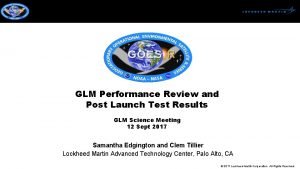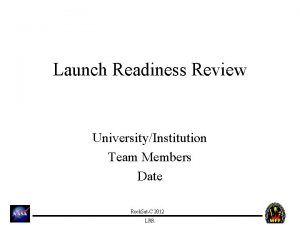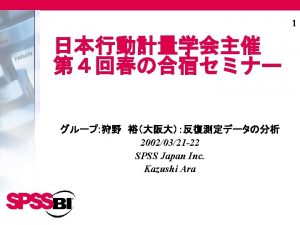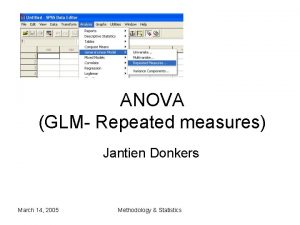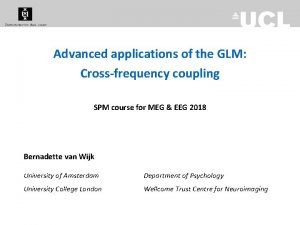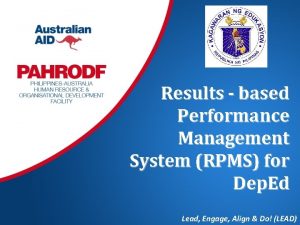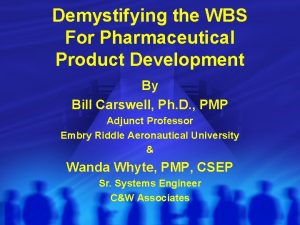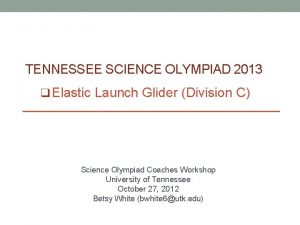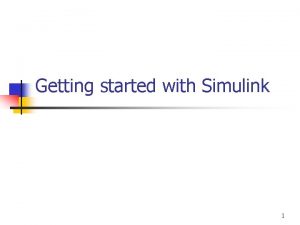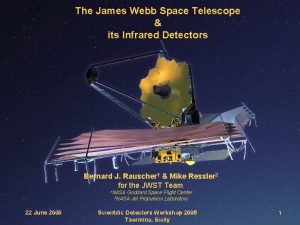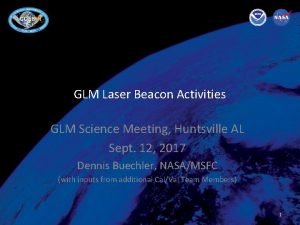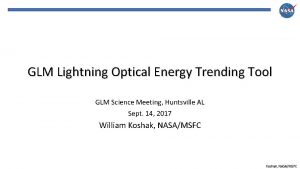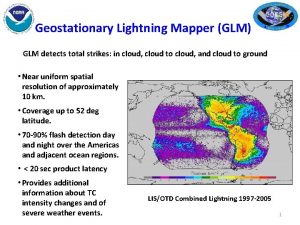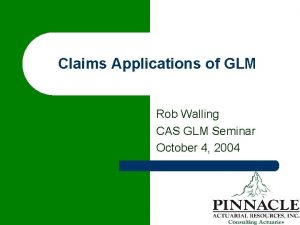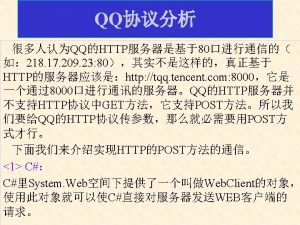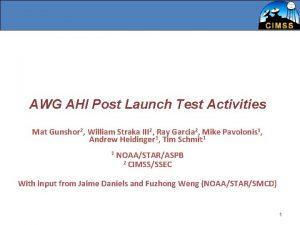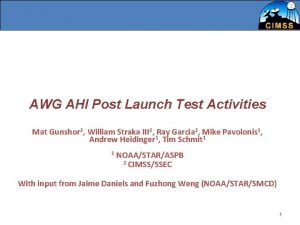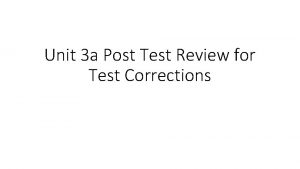GLM Performance Review and Post Launch Test Results



























- Slides: 27

GLM Performance Review and Post Launch Test Results GLM Science Meeting 12 Sept 2017 Samantha Edgington and Clem Tillier Lockheed Martin Advanced Technology Center, Palo Alto, CA © 2017 Lockheed Martin Corporation. All Rights Reserved.

Agenda • Data highlights • Ground system validation • Post Launch Test • Future – Image quality – Data Quality Product – RTEP thresholds – Algorithm Enhancements – Solar intrusion • Questions for the Community – Event filter and navigation parameter tuning • Long term trends • GLM performance – DE / FAR estimates – Navigation performance – Calibration – Impacts to performance from environment 2

GLM data highlights • As of the day of this presentation, GLM has acquired 10. 9 billion full disk images of the Earth 3

GLM data highlights Event totals as of 2017 -09 -06 Lightning 1. 36 e 10 Mask 2. 08 e 9 2 nd Level Threshold 3. 08 e 9 CCD Frame Transfer 5. 73 e 7 Radiation 1. 73 e 9 Coherency Fail 1. 98 e 9 Contrast Leakage 7. 63 e 9 Glint 4. 26 e 7 Burst 1. 66 e 8 Crosstalk 2. 54 e 6 Overshoot 1. 19 e 9 Noise time-out 4. 91 e 10 TOTAL 8. 07 e 10 4

GLM data • Every day, GLM sees about 50 million lightning events and about 1 million lightning flashes 5

GLM data • Hurricane Irma showed spectacular “Ring of Fire” eyewall lightning 6

Post Launch Test Overview • Each post launch test module is fully documented in CDRL 121 PLT Report PLT Follows Signal Chain: Electrons DN DN Events (downlink) Events Level 1 b Lightning Instrument tuning completed 12/9/16 1/4/17 Normal Mode Open Door GLM-001 1/4 - 1/7 GLM-007 1/7 - 2/21 GLM-002 12/19 - 4/20 Assess Image Quality On-Orbit Cal Tune RTEPs First Light We tuned thousands of parameters in the flight hardware and ground processing algorithms. They were delivered under CDRL 079 Calibration Data Books (currently at Revision H) GLM-INR-001&002 2/9 - 5/12 Tune Coastline ID and Event Navigation GLM-003&004 4/20 - 5/5 Tune Ground Processing Algorithms GLM-006 2/27 - 4/18 Hand-off to PLPT GPA Parameters are due to be loaded in ground system September 2017 PS-PVR 6/9/17 Assess Eclipse Stray Light Effects (x, y) to (lat, lon) 7

Image saturation statistics (1 of 2) • Example: 2 days of saturation statistics. Dynamic Range = headroom to saturation / threshold GLM has 1. 8 million pixels Night time Note log scale Sunset glint, primarily from blooming 2017 -08 -03 Night time Sunrise glint, primarily from blooming DR <= 1 means no lightning detection Noon. ~300 pixels saturated, primarily from overshoot 2017 -08 -04 8

Image saturation statistics (2 of 2) • This plot shows ~5 months of saturation data. On average, ~330 pixels are saturated at noon. Eclipse stray light blooming Sunrise glint Sunset glint Noon Dropped packets Midnight Each blue dot = one GLM background frame 9

RTEP threshold evolution during PLT Ground test thresholds • Once on orbit, the thresholds were tuned to account for the complex Earth scene and on orbit conditions • Thresholds were significantly lowered at high backgrounds – Lower thresholds = greater DE than prelaunch predictions Final PLT iteration (April 20 th) These are average thresholds across all 56 channels • Maximum event rate now at ~10, 000 per second – excluding blooming and maneuver events – There is room for further performance improvement by lowering thresholds 10

Blooming due to solar glint • The solar disk is ~50, 000 x brighter than the brightest clouds GLM observes • Solar glint occurs from specular reflections on bodies of water. The sun does not directly illuminate GLM optics. – Sunrise – Rivers, lakes, and calm oceans 17 minutes of sunrise glint ~8 million “lightning” events Greatest extent of blooming over 17 min. Bloomed pixels (no events) – Sunset • The specular reflection from a ~200 m wide river can temporarily saturate a GLM pixel. This is a feature of the detection method of GLM – Users can be advised via future GLM data quality product Blooming false events (yellow dots) occur on edge of charge “puddle” 11

Solar intrusion (GEO eclipse season) • Solar intrusion is when the sun shines directly into the GLM optics, near sub-satellite midnight during “eclipse season” MAGENTA = background (updated every 150 seconds) GREEN = events, including fronts of blooming false events. Normal event detection continues, to the extent allowed by data overflows. Most (not all) blooming occurs inside ZRDQ (Zones of Reduced Data Quality) 12

Spring 2017 solar intrusion statistics Overview of Spring 2017 eclipse season. The worst effect on GLM is during grazing passes (just before and after eclipse season) The worst-case observed intrusion in Spring 2017. Lightning detection continued unabated outside of bloomed areas. 13

Blooming false events Event Background (5 MSB) Event Intensity (DN) • Whether from glint or direct solar intrusion, blooming has a very distinct signature in GLM event data Example: events occurring in 5 pixels during a 45 -second time span The “puddle” of bloomed charge is advancing at 1 pixel every 6 seconds Each pixel goes from normal to bloomed in about 15 seconds Blooming events currently pass the coherency filter to become lightning. However, their distinct signature lends itself to being picked up by a new blooming event filter 14

GPA parameters • False event filters – During PLT we set the parameters for the ground processing algorithms – On-orbit data essential for setting algorithms for a new instrument – Coherency filter does the heavy lifting – need to balance DE vs FAR – Extremely stable platform lessens the need for contrast leakage filtering • Navigation – Navigation depends on identifying and registering coastlines in the background images – Set the parameters to perform this registration with on-orbit backgrounds Ground system is not yet using final GPA parameters 15

Trend data • All telemetry data is processed for trending metrics. We ingest the entire L 0 data stream with no bits left behind. • Diurnal cycle of the lightning event rate is offset from the noise event rate – as expected • Navigation trending shows the GLM offset angles have a stable and predictable diurnal cycle 16

Lightning detection performance • Predicted DE using: – On orbit thresholds, ground calibration data, & 1987 U 2 data as “truth” – No adjustments made for GPA removing true flashes – this will need to be evaluated during PLPT – Expect significant updates during PLPT and comparisons to ground validation ER-2 flights Mean = 86% 17

Lightning detection performance • Predicted FAR using: – LM L 1 B implementation – Single events isolated in time and space were considered false events – Depends on GPA parameters which can be adjusted Requirement for FAR average 18

Navigation performance • Coastline registration achieves < ½ pixel navigation error Error statistics referenced to ground RF detections include all of these: 1) GLM nav errors 2) ground nav errors 3) phenomenology (RF vs. optical) GLM group centroid error referenced to NLDN / GLD 360 2017 -05 -04 Credit: P. Bitzer Navigated coastlines (magenta) overlaid on background image of northern Gulf of California Position error Median ~5 km 19

Use of calibration in operations • L 2 data includes the energy of the events, groups, and flashes in Joules • At L 1 B we calibrate the events using ground calibration data – Each pixel has its own calibration – The calibration gives the event energy in Joules at the GLM aperture – The ground calibration test determines m. W/(sr-cm 2 -µm) per DN for each pixel – The calibration look up table delivered to the ground segment accounts for: • Size of the ground footprint for each pixel • The oxygen triplet throughput for each pixel • The following plots show power density and group area density in the fixed grid – Group density shows number of groups in each fixed grid bin, plotted on a log scale – Power density shows total energy in each fixed grid bin, divided by time (2 minutes), and scaled to estimate the emitted power rather than the power at GLM aperture, plotted on a log scale 20

Use of calibration in operations Energy per bin in fixed grid Groups per bin in fixed grid 2 1 Note regions 1 and 2 have similar energy density but more than an order of magnitude different group density 21

Impacts to on-orbit performance • Solar intrusion (eclipse season) • Glint blooming • Daily momentum adjust maneuvers Momentum adjust SPP motion • SPP maneuvers for solar instrument calibrations • Station keeping maneuvers have no effect (low-thrust arc jets) Sunrise glint 22

Evolution of the ground segment • Ground segment validation is still ongoing, with numerous bugs still to be resolved • LM is able to reprocess data from L 0 against the reference implementation of the GPAs • Long lead times for bug fixes are in conflict with planned provisional milestone for GLM Deployment Milestone Type Date Notes DO. 04 to OE Software 2017 -04 -24 20: 20 Z Filter parameters not yet tuned (lots of false events, poor DE) CDRL 079 Rev G to OE GLM Parameters 2017 -07 -05 17: 00 Z First data flow to GRB Prelim GPA filter tuning (May) DO. 05. 00 to OE Software Large nav errors, “duplication dots”, etc. CDRL 079 Rev H to OE GLM Parameters 2017 -09 -06 (anticipated) Improved GPA filter tuning per results of PLT GLM-004 (June) DO. 06. 00 to OE Software Expect continued large nav errors, “duplication dots”, etc. 2017 -07 -24 17: 00 Z 2017 -10 -30 (anticipated) 23

Ground segment validation • This is a highly abbreviated list of GLM ground segment issues that are being attacked in continued validation efforts between NASA, Lockheed Martin and Harris Corp. • Event Filters – “Duplication dots” or spurious duplicated events on 20 -second product boundaries that pass coherency – “Radiation dots” or single-pixel radiation hits that combine with instrument noise to pass coherency and drive up the flash false alarm rate • These can be removed at L 2 using a new filter in the LCFA • Navigation – Coastline ID does not currently produce the correct roll / pitch / yaw GLM offset angles, resulting in 10 s of km event geolocation errors – Event origination time is miscalculated by a factor of 1000 due to a unit conversion error • This appears to end users as a failure to account for time of flight – “Charlie Brown stripes” or group centroid locations showing abnormal stripe artifacts 24

Ground processing enhancements After we finish the ground system validation, we will have a working implementation of the ground processing algorithms as they were envisioned before launch. After analyzing almost a year of on-orbit data produced by GLM, a number of improvement opportunities are emerging. • Blooming false event filter • Data Quality Product • Navigation improvement by accounting for diurnal variation – Use ground networks to provide full-disk 24/7 reference dataset • Add flash filtering in LCFA • Use of lightning event energy density rather than flash density in operational products It will be advantageous to incorporate the lessons learned from PLT and PLPT to enhance the ground processing algorithms to extract even greater lightning detection performance out of GLM 25

Status of data quality product • The data quality product is a map of the GLM FOV showing areas where detection efficiency may be compromised – Must be separate from the lightning product – can’t tag an event that doesn’t exist – Shows the following features: • Where solar glint may occur • Where solar intrusion may occur (see ZRDQ at right) • Where events were dropped • Where pixels are near-saturated or saturated • PLT solar intrusion test determined the ZRDQ parameters • Latest ground processing algorithm description document (CDRL 080) defines the GLM data quality product • Next step: consideration by Algorithm Review Board 26

Questions to the Science Community • How can we improve GLM data products? – For forecasters – what do you see on your display? What would you rather see? – For scientists – is there anything you need to know about the instrument that you don’t already know? • What is the right balance between DE and FAR? – Currently favors FAR at expense of DE, until L 2 filtering is implemented • Are there useful things to be done with GLM East/West stereo views of lightning? • What would you like to see improved or added in a next-generation GLM? 27
 Post launch review
Post launch review Launch readiness review
Launch readiness review Launch readiness review
Launch readiness review Dhyah
Dhyah Glm mat3 constructor
Glm mat3 constructor Glm repeated measures spss
Glm repeated measures spss Do
Do Glm
Glm Glm cross
Glm cross Optimal driver launch angle and spin rate chart
Optimal driver launch angle and spin rate chart Result based performance management system
Result based performance management system The heart of rpms falls under
The heart of rpms falls under Algebra 2 unit 1 test
Algebra 2 unit 1 test Narrow product launch windows
Narrow product launch windows Productlaunchformula
Productlaunchformula Nphce programme
Nphce programme Let down in the deep
Let down in the deep Ideas for yammer posts
Ideas for yammer posts The openblend podcast
The openblend podcast Wbs for new product launch
Wbs for new product launch Narrow product launch windows
Narrow product launch windows Elastic launch glider
Elastic launch glider Bob's place dandenong
Bob's place dandenong Jwst launch
Jwst launch Simulink
Simulink James webb space telescope nasa
James webb space telescope nasa Should you launch a fighter brand
Should you launch a fighter brand Syngenta new product launch
Syngenta new product launch
